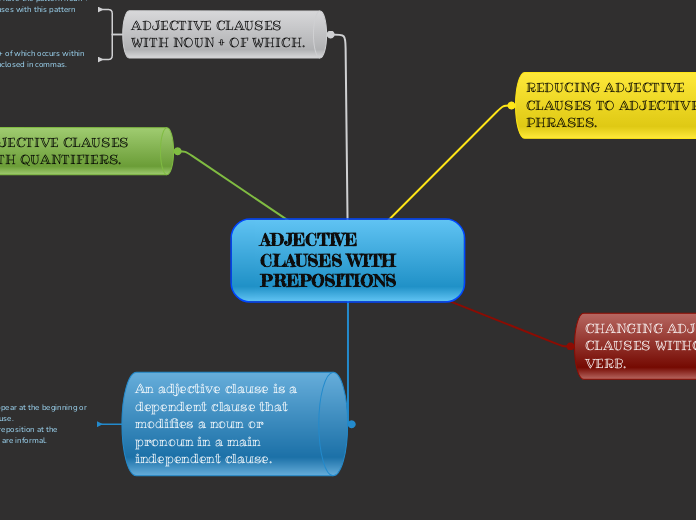ADJECTIVE CLAUSES WITH PREPOSITIONS
An adjective clause is a dependent clause that modifies a noun or pronoun in a main independent clause.
-The preposition can appear at the beginning or end of the adjective clause.
- Sentences with the preposition at the beginning of the clause are informal.
EXAMPLES: 1- Bill iis the man to whom I spoke.
2- That's the book to which he referred.
ADJECTIVE CLAUSES WITH QUANTIFIERS.
Some adjective clauses have the pattern quantifier + of + relative pronoun.
Quantifiers occur only in clauses with whom, which, and whose. These clauses may refer to people or things.
EXAMPLE: He has made many friends at the university, all of whom he likes.
ADJECTIVE CLAUSES WITH NOUN + OF WHICH.
If a clause with a noun + of which occurs within the main clause, it is enclosed in commas.
EXAMPLE: International celebretions, occurences of which are common at my university, are a welcome change to the usual routine.
Some adjective clauses have the pattern noun + of which. Adjective clauses with this pattern refer to things.
EXAMPLE: New York City has many impressive tourist attractions, an example of which is the Empire State Building.
CHANGING ADJECTIVE CLAUSES WITHOUT A BE VERB.
If there is no be verb in an adjective clause, it is often possible to change the adjective clause to an adjective phrase. To do this, delete the relative pronoun and change the verb to its -ing form.
EXAMPLES: 1- Frank Okawilo, who currently studies at Harvard University, is going to graduate this year.
2- Frank Okawilo, currently studying at Harvard University, is going to graduate this year.
REDUCING ADJECTIVE CLAUSES TO ADJECTIVE PHRASES.
Unlike a clause, a phrase is a group of words that does not have both a subject and a verb showing time. Adjective clauses with a be verb can be reduced to adjective phrases.
If an adjective clause needs commas, the corresponding adjective phrase also needs commas.
EXAMPLE: The Guggenheim Museum, which was founded in 1939, is very popular.
To reduce an adjective clause with a be verb, delete the relative pronoun and the be verb.
EXAMPLE: Any student who is studying abroad must learn the language of the country.









